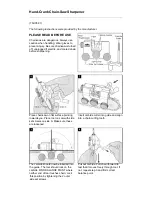
RTW 300W 042111
9
NOTE: To prevent oscillations, install one external electrolytic (do NOT use tantalum) capaci-
tor, rated 470µF min. between the (+) and +S terminals and one between the (–) and –
S terminals (see Figure 7).
FIGURE 7. CORRECT AND INCORRECT METHODS OF LOAD CONNECTION
6.3
PARALLEL CONNECTION
RTW 300W Power Supplies can be connected in parallel (with or without N+1 redundancy). Use
twisted or shielded wire for connection to RV and –S terminals. The impedance of the load wires
between each power supply and load should be the same as close as possible.
For a single remote ON-OFF signal to turn off all parallel-connected units, connect together all
+RC terminals and connect together all –RC terminals. Figure 8 illustrates connection of up to four
(maximum) power supplies in parallel. Output current for a parallel connection operating into a
single load is equalized by connecting the CB and –S terminals as shown. Refer to PAR. 6.3.1 for
conditions required for proper current equalization (balancing). Optional Cable Kit 219-0497 (PAR.
6.6) may facilitate connections.
N+1 Redundancy.
An N+1 system requires one additional power supply than necessary to supply
the load. If one of the parallel-connected units fail, the others will continue to provide power to the
load without down time. For redundancy, add isolation diodes as shown in Figure 8.


































